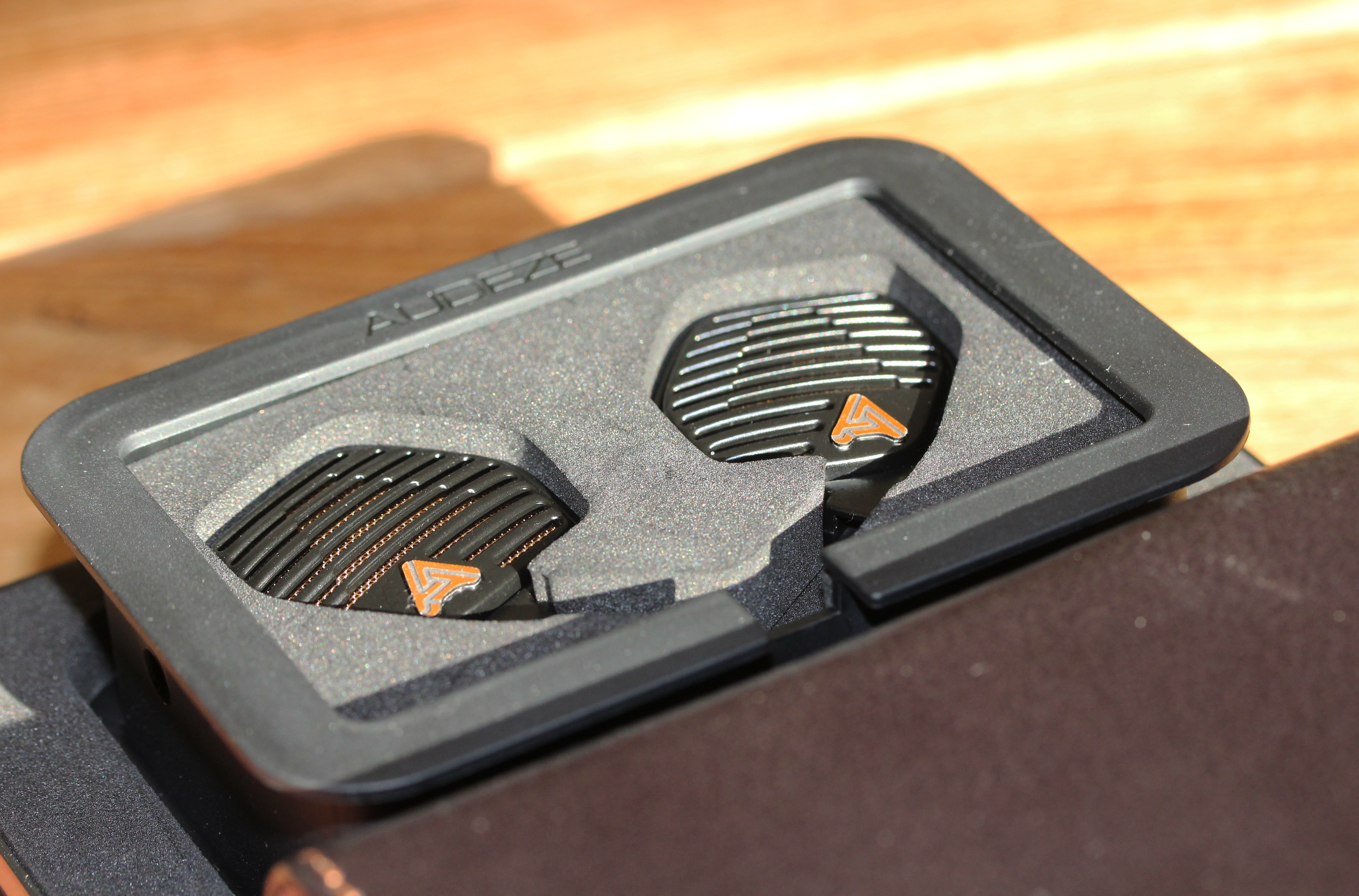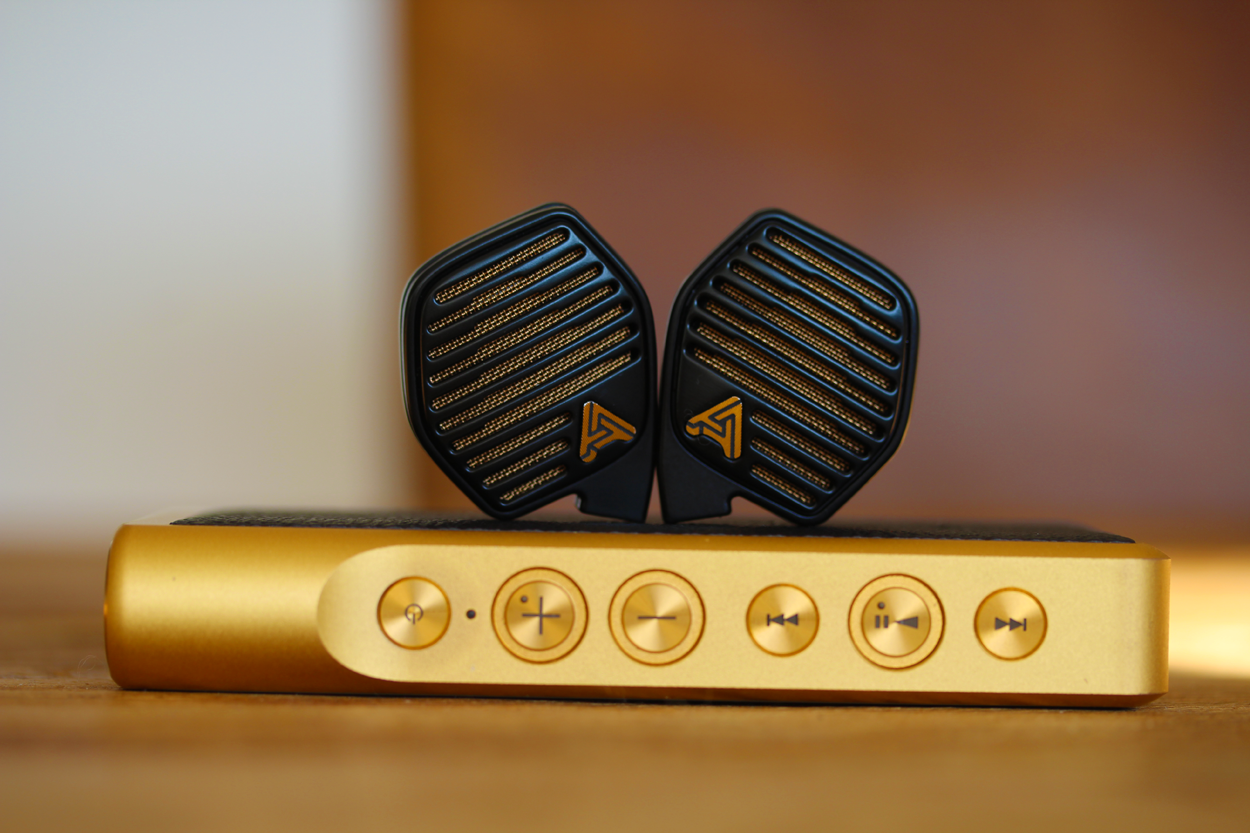Source pairing
The i4’s most optimal use is when listened via a USB DAC or desktop system, with the provided DSP settings. However, when listened directly via a DAP the EQ can be manually adjusted by ear to approach Audeze’s target curve. However, it remains a bit tricky to get the tone exactly right. So surprisingly, one of the best pairings is by simply using an iPhone with the Cipher cable. The i4’s stage might not be as large as with a high quality dap, but the timbre is just right. It offers the same clear sound, but a warmer tone in the midrange makes for more natural vocals and a significantly more accurate timbre, while still offering a clear and highly detailed treble.
When using a DAP, the i4 tends to have an exceedingly neutral tonality. It’s not necessarily bright, but the midrange isn’t inherently warm either. In addition, its vocal presentation is relatively laid-back, although this can simply be adjusted with EQ. For instance, the Lotoo Paw Gold is a personal favorite as its bodied vocal reproduction creates a solidified, forward sound, while adding a sense of energy throughout its signature. However, I EQ the mid- to upper-treble region down in order to create a smoother sound, with a more natural timbre.
By comparison, my modded Sony WM1Z provides a powerful bass with a neutral tonality that fairs well with the i4’s sense of space and precision, although I tend to EQ a little more in the midrange for vocal density. By contrast, it’s more difficult to achieve a sense of naturalness in its midrange. Though not excessively warm, both the A&Ultima SP1000 Cu and AK380cu handle upper treble smoothly, adding a lightly warm and smooth touch to the i4’s clear sound, while maintaining a relatively neutral tonality. I found the pairing with either to be among the best, followed by the LPG.

Comparisons
Spiral Ear 5-Way Ultimate (€1799)
A long-standing icon for timbre, the 5-Way impresses with its resolution and staging, in defiance of its warm and soothing tone. Exceeding naturalness as a priority, but within a bigger picture. Yet despite their difference in technology and even tonality, the 5-Way and i4 aren’t miles apart when it comes to the core of their presentation: a three-dimensional stage, with a neutral instrument placement in terms of forwardness. And more importantly, both iems depict their own interpretation of naturalness. The i4 creates a realistic representation of its instruments by means of its high definition, and quick transient response, and the 5-Way with its overall warmer timbre.
Down low, they converge with natural-sounding and technically capable bass, albeit in different interpretations. Both offer good bottom-end extension, with capable speed and decay, while hovering around neutral in overall quantity. But the 5-Way’s bass is significantly warmer in tone, where the i4 maintains a similar sense of naturalness, with a lighter tone. And while they share similarities in the density and forwardness of their vocals, the 5-Way’s are just a bit more bodied, and warmer in tone. But their greatest difference perhaps is in their treble tuning, with the i4 offering greater clarity throughout its signature, besides a more neutral in tone. Its treble is not only quicker, but clearer, resulting in a greater sense of detail. This returns in the way they construct their stage; while the 5-Way offers a spacious, three-dimensional stage, it can’t match the airiness and following openness of the i4.
Empire Ears Legend-X ($2399)
How different with the Legend-X, Empire’s recent addition boasting two dynamic drivers in a hybrid configuration. Its forward treble gives it an energetic, but also slightly aggressive, character. Bolstered by its powerful bass, the Legend is a young gun that can’t contain its excitement. Compared to the Legend, the i4 eludes a sense of calmness and wisdom; a more mature presentation. The i4 has the more natural bass, lightly warm, and exquisitely balanced between sub- and upper-bass. A delicately refined bass, that does a lot of things right. The Legend’s bass wasn’t tuned for balance; it was tuned for power – a deep, rumbling bass with emphasis on its sub-bass, and clarity in its impact.

Even so, both are surprising close in tone, boasting a generally neutral tonality. An overall clear sound, without sounding bright. However, after DSP correction the i4 offers the more natural midrange, with a relatively more accurate timbre. The Legend-X’s signature in turn diverges with more sparkle in its upper treble. While both create a bodied sound, the i4’s vocals are smoother, while exuding greater balance. In addition, the i4’s stage is more homogenous in proportions, as well as airier; that aforementioned bass has consequences of its own. Accordingly, the i4’s presentation is cleaner, resulting in more effortless separation. While offering sufficient depth, the Legend’s stage is primarily wide, with a more forward placement.
Vision Ears VE8 (€2399)
Although inherently different in a variety of aspects, the i4 and VE8 equally share several general characteristics. For starters, both have a relatively neutral tone, and an overall smooth and engaging presentation. The VE8 by means of its forward staging and bodied midrange, while the i4 envelops the listener with its balanced presentation, and holographic stage. While the VE8 equally offers a spacious stage, it primarily relies on its width for its separation. In addition, the VE8 offers a smoother tone with a modest touch of sparkle, while the i4’s treble sounds just a bit crisper.
The VE8’s bodied sound partially stems from its enhanced mid- and upper-bass. It’s an engaging bass, although its emphasis resides on the upper registers. It’s not a boomy bass by any means, but its impact follows from its mid-bass body, rather than its sub-bass power. The i4’s bass in turn provides deeper extension, with greater balance between the sub- and mid-bass. A bass that allows it to provide a nice touch of impact upon request, while remaining neutral in quantity, and airy in its approach.

Conclusion
The i4 is, without a doubt, the most unique earphone I have reviewed till date – and admittedly, the reason it took a while to write up. The unique properties of its planar driver, open back design, and various adjustment options set it apart from contemporary iems, resulting in a unique listening experience, combined with some practical constraints. In a way, the i4 is almost equal parts high-end in-ear, and high-tech gadget. And just like when discovering any new technological advancement, it tends to require some playing around to get right.
In the case of the i4, it’s by experimenting with DSP and manual EQ. Of course, the i4 doesn’t ‘need’ EQ to sound good. Audeze’s DSP settings aren’t intended to alter the foundation of its sound, such as its tone or staging capabilities. Rather, the presets help to adjust the vocal reproduction, by enhancing the density and forwardness of the vocal range, while simultaneously improving its timbre.
For those willing to invest some time and effort, there are exclusive benefits to reap. For starters, the i4’s natural portrayal of sound. This doesn’t just refer to its tonality, but the way it presents the music: the realistic use of space, its transient response, and the delicate flow of the music. And most importantly, the contrast between the clarity of its treble with a beautiful midrange, matched by the naturalness of its bass. A spacious and open sound, employing the full advantage of its special driver.
Audeze LCDi4
-Design: Single planar driver
-MRSP: $2495
Manufacturer website
https://www.audeze.com/products/lcdi-series/lcdi4-ear-headphone




4 Responses
Hi there, I can give some general settings, but it also really depends on the warmth/brightness of the source (besides personal preference). Also, some sources have a broader EQ band so you can fine tune more precisely.
This is what I used for my modded WM1Z:
31 +4
62 +4
125 +1
2 +4.5
4 +5.5
8 -3
16 -3
Could you share some EQ settings? Thanks.
Hi Clarence, there are some cables that can add a slight bump to the midrange, such as the plusSound gold-plated copper or tri-copper. However in this case, I would resort to EQ first to fine-tune the sound, if DSP is not an option.
Great in depth review, do you have any after market cables recommend for its midrange deficiency?